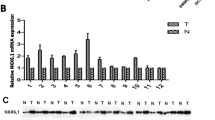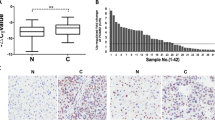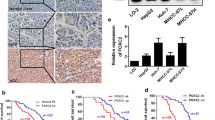Abstract
Growth arrest-specific homeobox (GAX) codes for a transcription factor and plays a crucial role in many human cancers. Previous tumor studies have shown GAX may act as a suppressor of growth, invasion, and metastasis. However, little is known as to its role in hepatocellular carcinoma (HCC). Our aim was to investigate the expression of GAX in HCC and to make correlations with clinicopathologic features. Twenty-five pairs of HCC and adjacent non-tumor tissues, and six normal liver tissues were collected for GAX detection by Western blotting and real-time-PCR analysis. Immunohistochemistry was used to determine the expression of GAX in HCC and adjacent non-tumor tissues from 96 patients. Reduced expression of GAX was significantly associated with Edmondson stage, vascular invasion, and capsule invasion. Moreover, Kaplan–Meier curves showed that lower GAX expression was associated with shorter overall survival and disease-free survival in HCC patient. In conclusion, our study demonstrates for the first time that downregulated expression of GAX is an independent prognostic factor and is correlated with poor survival in HCC patients.



Similar content being viewed by others
References
Srivatanakul P, Sriplung H, Deerasamee S. Epidemiology of liver cancer: an overview. Asian Pac J Cancer Prev. 2004;5(2):118–25.
Di Bisceglie AM. Issues in screening and surveillance for hepatocellular carcinoma. Gastroenterology. 2004;127:S104–7.
El-Serag HB, Marrero JA, Rudolph L, Reddy KR. Diagnosis and treatment of hepatocellular carcinoma. Gastroenterology. 2008;134:1752–63.
El-Serag HB, Rudolph KL. Hepatocellular carcinoma: epidemiology and molecular carcinogenesis. Gastroenterology. 2007;132(7):2557–76.
Gorski DH, Walsh K. Control of vascular cell differentiation by homeobox transcription factors. Trends Cardiovasc Med. 2003;13(6):213–20.
Gorski DH, LePage DF, Patel CV, Copeland NG, Jenkins NA, Walsh K. Molecular cloning of a diverged homeobox gene that is rapidly down-regulated during the G0/G1 transition in vascular smooth muscle cells. Mol Cell Biol. 1993;13(6):3722–33.
Gorski DH, Leal AJ. Inhibition of endothelial cell activation by the homeobox gene GAX. J Surg Res. 2003;111:91–9.
Smith RC, Branellec D, Gorski DH, et al. p21CIP1 mediated inhibition of cell proliferation by overexpression of the GAX homeodomain gene. Genes Dev. 1997;11:1674–89.
Yamashita J, Itoh H, Ogawa Y, et al. Opposite regulation of GAX homeobox expression by angiotensin II and C-type natriuretic peptide. Hypertension. 1997;29:381–7.
Fisher SA, Siwik E, Branellec D, Walsh K, Watanabe M. Forced expression of the homeodomain protein GAX inhibits cardiomyocyte proliferation and perturbs heart morphogenesis. Development. 1997;124(21):4405–13.
Patel S, Leal AD, Gorski DH. The homeobox gene GAX inhibits angiogenesis through inhibition of nuclear factor-kappaB-dependent endothelial cell gene expression. Cancer Res. 2005;65(4):1414–24.
Zhou P, Jiang W, Wu L, Chang R, Wu K, Wang Z. miR-301a is a candidate oncogene that targets the homeobox gene GAX in human hepatocellular carcinoma. Dig Dis Sci. 2012;57(5):1171–80.
Cao G, Huang B, Liu Z, et al. Intronic miR-301 feedback regulates its host gene, ska2, in A549 cells by targeting MEOX2 to affect ERK/CREB pathways. Biochem Biophys Res Commun. 2010;396(4):978–82.
Ohshima J, Haruta M, Arai Y, et al. Two candidate tumor suppressor genes, MEOX2 and SOSTDC1, identified in a 7p21 homozygous deletion region in a Wilms tumor. Genes Chromosomes Cancer. 2009;48(12):1037–50.
Teufel A, Staib F, Kanzler S, Weinmann A, Schulze-Bergkamen H, Galle PR. Genetics of hepatocellular carcinoma. World J Gastroenterol. 2007;13:2271–82.
Abate-Shen C. Deregulated homeobox gene expression in cancer: cause or consequence? Nat Rev Cancer. 2002;2(10):777–85.
Krumlauf R. Hox genes in vertebrate development. Cell. 1994;78(2):191–201.
Witzenbichler B, Kureishi Y, Luo Z, Le Roux A, Branellec D, Walsh K. Regulation of smooth muscle cell migration and integrin expression by the GAX transcription factor. J Clin Invest. 1999;104(10):1469–80.
Chen Y, Leal AD, Patel S, Gorski DH. The homeobox gene GAX activates p21WAF1/CIP1 expression in vascular endothelial cells through direct interaction with upstream AT-rich sequences. J Biol Chem. 2007;282(1):507–17.
Chen Y, Rabson AB, Gorski DH. MEOX2 regulates nuclear factor-kappaB activity in vascular endothelial cells through interactions with p65 and IkappaBbeta. Cardiovasc Res. 2010;87(4):723–31.
Li Q, Ding J. Gene expression analysis reveals that formation of the mouse anterior secondary palate involves recruitment of cells from the posterior side. Int J Dev Biol. 2007;51(2):167–72.
Jin JZ, Ding J. Analysis of Meox-2 mutant mice reveals a novel postfusion-based cleft palate. Dev Dyn. 2006;235(2):539–46.
Wu Z, Guo H, Chow N, et al. Role of the MEOX2 homeobox gene in neurovascular dysfunction in Alzheimer disease. Nat Med. 2005;11(9):959–65.
Valcourt U, Thuault S, Pardali K, Heldin CH, Moustakas A. Functional role of Meox2 during the epithelial cytostatic response to TGF-beta. Mol Oncol. 2007;1(1):55–71.
Pfaff N, Fiedler J, Holzmann A, et al. miRNA screening reveals a new miRNA family stimulating iPS cell generation via regulation of Meox2. EMBO Rep. 2011;12(11):1153–9.
Chen Y, Gorski DH. Regulation of angiogenesis through a microRNA (miR-130a) that down-regulates antiangiogenic homeobox genes GAX and HOXA5. Blood. 2008;111(3):1217–26.
Chen Y, Banda M, Speyer CL, Smith JS, Rabson AB, Gorski DH. Regulation of the expression and activity of the antiangiogenic homeobox gene GAX/MEOX2 by ZEB2 and microRNA-221. Mol Cell Biol. 2010;30(15):3902–13.
Conflict of interest
None.
Author information
Authors and Affiliations
Corresponding author
Rights and permissions
About this article
Cite this article
Zhou, P., Chen, Z., Chang, RM. et al. Growth arrest-specific homeobox is associated with poor survival in patients with hepatocellular carcinoma. Med Oncol 29, 3063–3069 (2012). https://doi.org/10.1007/s12032-012-0258-0
Received:
Accepted:
Published:
Issue Date:
DOI: https://doi.org/10.1007/s12032-012-0258-0




